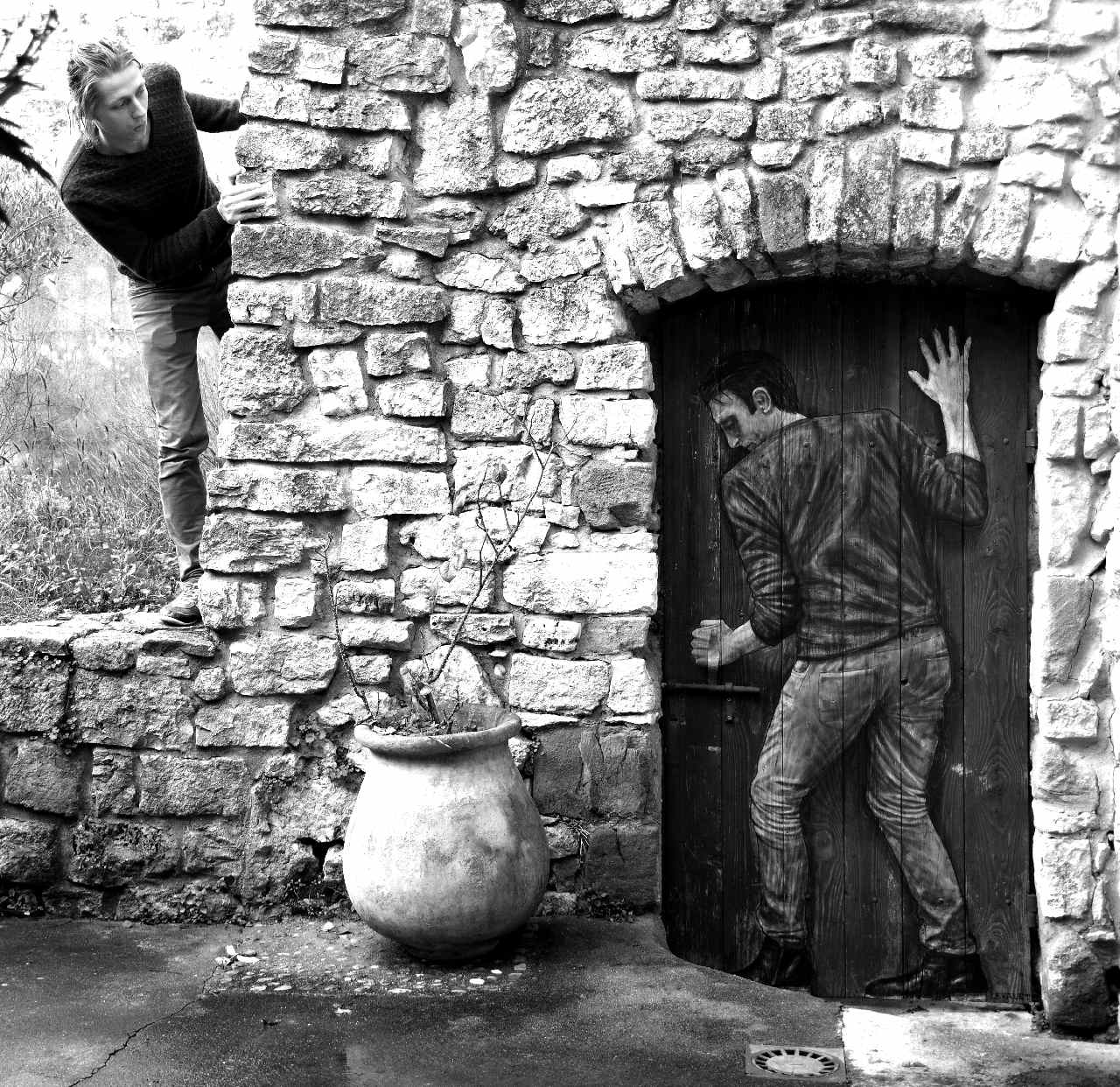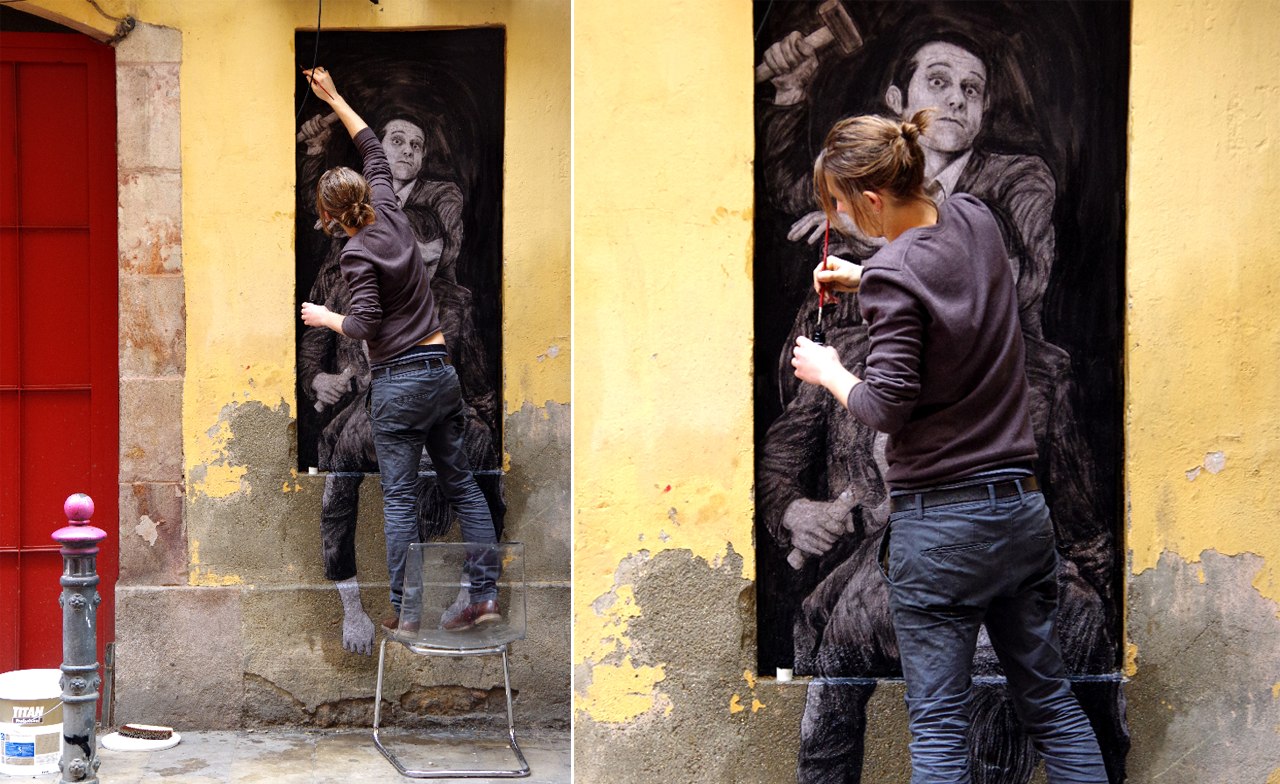
Levalet painting, Courtesy of the artist and OPEN WALLS Gallery
Every once in a while, street art enthusiasts are treated with an opportunity to discover a truly creative artist, the one who will bring art into their lives in unexpected and innovative ways. With his career on the steady rise, Charles Leval aka Levalet is currently one of the most interesting young artists on the urban art scene. Levalet gained international recognition with his clever and subtle public interventions, as well as his signature whimsical characters in Indian ink, scattered on the European streets. The art of Levalet is constantly evolving, going beyond drawings and paste-ups, and touching upon various media. Nonetheless, some of the constants in his works are explorations of everyday situations and social settings, representations of mundane narratives transformed through his strong sense of absurd and specific sense of humor.
Few weeks ago, we talked about Levalet’s art in a wider context of urban art interventions, mapping his work within this rich tradition of public art. Today, we are particularly interested in specifics of his creative process, revealing what makes Levalet so unique and original. In order to do that, we shared a talk with the young French artist, gaining insight into the evolution of his art from the early days of his career to the hopes for the future.
In the interview bellow, Levalet talks about his inspiration and influences, the complexity of his artistic methods, evolution of his technique, and much more. This is an amazing chance to find out more about the artist who has captivated the urban art audience with his witty imagery, so scroll down and have a read!

Levalet pasting Frontière, 2014, Courtesy of the artist and OPEN WALLS Gallery
Beginnings and Influences
OPEN WALLS: Can you tell us something about your beginnings as an artist? What motivated you to pursue an artistic career, how and when did it all start and what is the role of formal art education in this regard?
Levalet: I started to become interested in art and in the whole area of visual imagery in general at the age of 12 or 13 when I discovered graffiti, and Photoshop too. I started to study plastic arts when I was 17 and I continued doing so right through to 2012, when I became a professor of plastic arts. Since the start of my studies, I have always kept working prolifically, touching on all media from painting and photography right through to video installations. Initially, I never thought I would be able to make a living from my art, but this became possible once I started to exhibit in galleries in 2013.
OPEN WALLS: Who are your biggest influences – people, movements, styles you looked up to while establishing your visual language?
Levalet: I have many influences and they are so eclectic that it is difficult for me to narrow them down to just a few artists. I have been influenced to similar degrees by the paintings of Veronese, the assemblages of Picasso and the films of Buster Keaton. During my studies, I drew on lots of different sources, but perhaps I should mention the activities of the nouveaux réalistes, the whole area of video installations with artists like Pierrick Sorin or Bill Viola, photographers such as Jeff Wall, silent films, semiology, the new wave of French comics, and artists such as Varini and Pignon-Ernest who worked in a site-specific manner. Today, I draw my inspiration from everything that surrounds me: advertising, theatre, cinema…

Levalet working on Lettre à l’oubli, 2013, Courtesy of the artist and OPEN WALLS Gallery
Style Characteristics, Creative Process and Favorite Themes
OPEN WALLS: How would you describe your style in terms of techniques, mediums, materials you use etc.? What are the specific features that make your work unique and original?
Levalet: If I had to choose one defining characteristic of my drawings, I would say that I adopt an objective style to the extent that my drawings are realistic without being photorealistic, and that I place great importance on the physical coherence of my characters. In my street art, my first requirement relates to the actual space that my drawings will have to fit into in a coherent and meaningful manner. In my work for galleries, I place more importance on the DIY nature of my works and on my investigations of combinations of objects, various materials and drawn figures.
OPEN WALLS: What does your creative process look like?
Levalet: When I work in a site-specific manner, I always start by investigating the site itself: I take photos and measurements, and think about my project considering the specific features of the site as my starting point. Once an idea starts to form, I make preparatory sketches, and then create the designs that will serve as the basis for my drawings. I gather photos or take my own photos of people in positions similar to those necessary for the completion of my project. I draw my characters and the other elements in my studio, and it is only when this preparatory work is complete that I return to the site to install my paste-ups.
OPEN WALLS: What are the themes you usually tackle in your work and why are they of particular interest to you?
Levalet: The starting point for my works is often an observation of everyday life or social analysis. In general, I play with a reappropriation of these public situations to emphasise one of their characteristics or to highlight some absurd element in them. Sometimes, I also make use of a type of surrealism to decontextualise or even to denormalise the situations that I wish to showcase.

Levalet, Effraction, 2015, Courtesy of the artist and OPEN WALLS Gallery
Levalet’s Work throughout the Years
OPEN WALLS: Can you describe the evolution of your style over the years? Are there any important phases in your career you would like to highlight?
Levalet: I have always had the same interests as regards the background for my work. The manner of presentation has always been important in my work as a means to draw meaning from a situation that is also being made fun of. If my work is evolving, then this tends to be from the viewpoint of technique. Around 2007 it was more pictorial; around 2009 it was more focused on animation; around 2010 I was working a lot with video installations. Drawing has been at the core of my work since 2012. For a few years now, it has been becoming more and more sculptural.
OPEN WALLS: Which project, exhibition, artwork etc. do you find most significant in your work so far? Can you single out some important milestones in your career? `
Levalet: I don’t regard my works as being in competition with each other; instead, I see them as being complementary. I have the feeling that each piece continues on from the one before it, and I keep making return journeys back to my original starting point from both a semantic and technique-related viewpoint.

Making of Sucession, Barcelona, 2015, Courtesy of the artist and OPEN WALLS Gallery
Thoughts on the Future
OPEN WALLS: What are the messages you’re trying to impart to your audience and what are the responses (feelings, questions, thoughts…) you hope to provoke?
Levalet: I am not trying to pass on any message in particular: I don’t consider myself a militant artist, my work is not trying to defend a specific cause or to convey a single, unequivocal outlook. With my work, I hope to arouse wonder and then provoke questioning, but there is no answer to these questions hidden in the works. I try not to be too heavy-handed with the meaning of my works so that they will remain open to interpretation for everyone.
OPEN WALLS: What are your goals for the future?
Levalet: There are lots of things I would like to do: I have several ideas for exhibitions, I would like to do site-specific work on a larger scale, to return to video, to do books… but I just don’t have enough time!